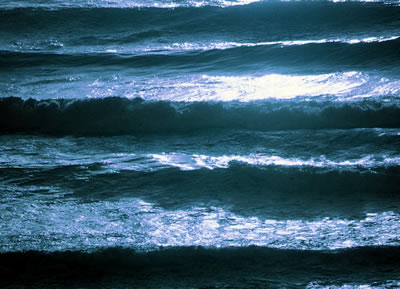When we see waves rolling into and breaking on a shore, it seems as if all the water is moving horizontally. But it is mainly energy and not water that is being moved. Waves possess kinetic energy and in them this energy derives from the orbital movement of water molecules, which move up and down and in small circles - but not horizontally because most of the water is not being moved along. The energy of a wave can be quite substantial; for instance, when a wave 1.3m high breaks on the shore it releases the equivalent of about 16.5 megawatts of power per kilometer of shoreline.
The greatest amount of wave energy in ocean waters is derived from small wind-generated waves. Like the currents on the surface of the ocean, most waves are caused by wind blowing over the water. A gentle breeze of only 1 km/h can create ripples, or capillary waves; but because the ripples present a greater surface area to the wind, there is additional friction and pressure, which increase the length of the waves. This, in turn, results in a greater velocity, so that eventually the waves may reach the same speed as the wind.
Waves usually reach about 3m in height, but can range from mere ripples to about 15m high; the highest wave height ever measured was 34m. The height of waves increases with the speed of the wind and the length of time it has been blowing, and the distance the wind has traveled over the ocean - called the fetch.
The wind speed in metric knots (1 knot = 1.85km/h) is about twice the wave height in meters. Waves with a short wavelength tend to disperse because they lose height when they collide with each other. But waves with longer wavelengths move more rapidly.

Most wind-driven waves start as deep-water waves, where the depth of the water is more than half their wavelength. Waves in the ocean consist of different wave-trains of varying wave height and length, each wave-train moving at its own speed. When the wave in front of the train moves into still water, some of its energy is transferred to the water molecules in the undisturbed water, which starts their orbital motion. In this way the leading wave is perpetually losing its energy and dispersing, and it is replaced by the next wave, which undergoes the same process. The water molecules continue their motion after the train has passed and a new wave is created at the end of the train.
The wind-generated waves that reach a shore change in nature and gradually become shallow water waves. The orbital motion of the water particles differs in shallow water; whereas in deep water the movement is circular with each circle decreasing in size with increased depth, shallow water particles move in an increasingly elliptical motion with increasing depth until their movement is linear, and they move back and forth.
When a deep-water wave comes within a depth that is half its wavelength, it is bent, or refracted. At this depth the wave slows down which causes its length to decrease, and the leading part of the wave moves slower than the rest of the wave. The effect of refraction can be seen as a wave approaches the shore and seems to bend around so that it breaks almost parallel with the shore. At this stage it also differs from a deep-water wave in that all the waves in a train in shallow water have the same velocity for a particular depth.
As the wave reduces its speed the waves-behind it, which are moving faster, start to pile up. The result is an increase in the height of the wave and a compression of the motion of the water particles.
The orbital speed of the particles decreases in the trough of the wave but not at the crest, making the wave increasingly less stable. By the time the angle from the inside center of the base of the wave to the crest is more than 120°, and the ratio of the wave's height to its length exceeds 1:7, the crest is moving at a greater speed than the rest of the wave; it overshoots the rest of the wave and the water breaks. At this point the crest is sometimes moving at double the speed of the wave.
Waves break on the shore when the water depth below them is about 1.3 times the wave height; a 6m wave, for example, breaks in 8m of water.